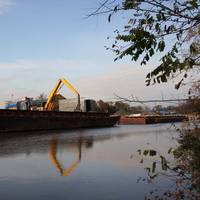EPA Proposes Ban on Sewage Dumping in St. Lawrence River
The U.S. Environmental Protection Agency (EPA) has determined that a “no discharge zone” can be established for the New York State portion of the St. Lawrence River. The New York State Department of Environmental Conservation petitioned the EPA to prohibit boats from discharging sewage into the river by establishing a “no discharge zone” for the area. The EPA has reviewed the state petition and found that there are adequate facilities around the St. Lawrence for boats to pump out their sewage, rather than dumping it in the water. “It’s astonishing that in 2016, boaters can dump raw sewage into the St. Lawrence River. Declaring this area of the St. Lawrence a “no discharge zone” would provide cleaner water for people who use this river,” said Regional Administrator Judith A. Enck.
Sixth Season of Hudson River Dredging Begins

U.S. Environmental Protection Agency Regional Administrator Judith A. Enck announced the start of the sixth, and final, season of dredging of PCB-contaminated sediments from the bottom of the Hudson River. The historic dredging project – one of the largest and most complex cleanups in Superfund history – began in 2009. The EPA is overseeing the dredging project that is being conducted by General Electric Company (GE) under the terms of a 2006 legal agreement. According to GE, the company has invested more than $1 billion on the cleanup project to date.
No Discharge Zone Declared in Lake Erie
The U.S. Environmental Protection Agency and the New York State Department of Environmental Conservation today declared the New York side of the Lake Erie shore line a “no discharge zone,” which means that boats are completely banned from discharging sewage into the water. The EPA reviewed the New York State Department of Environmental Conservation’s proposal to establish a no discharge zone for the lake and determined that there are adequate facilities in the area for boats to pump out their sewage. Boaters must now dispose of their sewage at one of the lake’s specially-designated pump-out stations. This action is part of a joint EPA and New York State strategy to eliminate the discharge of sewage from boats into the state’s waterways.
EPA Helps Cut NYC Marine Diesel Engine Emissions
The U.S. Environmental Protection Agency is supporting local efforts to reduce air pollution in the New York City metropolitan area by providing a total of $1.1 million to help two organizations replace old, dirty diesel engines on boats with less polluting models. The projects will cut emissions of harmful nitrogen oxides and particulate matter among other pollutants. These pollutants are linked to health problems, including asthma, lung and heart disease and premature death. Diesel engines often remain in use a long time. Older diesel engines that predate current and stricter air pollution standards emit large amounts of air pollutants.
Toxics Dredging Resumes in the Hudson

The U.S. Environmental Protection Agency (EPA) announced today that dredging operations are expected to resume on Wednesday in the Upper Hudson River. In 2014, dredging will begin south of Schuylerville, New York and proceed south towards Troy. Dredging will also occur in a two-mile section of river near Fort Miller that is not easily accessed by boat. Dredging is being conducted to remove sediment from the river bottom that is contaminated with polychlorinated biphenyls (PCBs).
$2.7M EPA Grant to Replace Tug Engines
EPA Invests $2.7 Million to Reduce Air Pollution from Old Diesel Engines in New York and New Jersey. The U.S. Environmental Protection Agency has provided a total of $2.7 million to help two organizations reduce air pollution in the New York metropolitan area by replacing old, dirty diesel engines on a tug boat and two trains with less polluting models. The projects will cut emissions of harmful nitrogen oxides by 70 tons per year and particulate matter by three tons per year. These pollutants are linked to health problems, including asthma, lung and heart disease and even premature death. Diesel engines are durable and often remain in use a long time. Older diesels that predate current and stricter air pollution standards emit large amounts of air pollutants.





